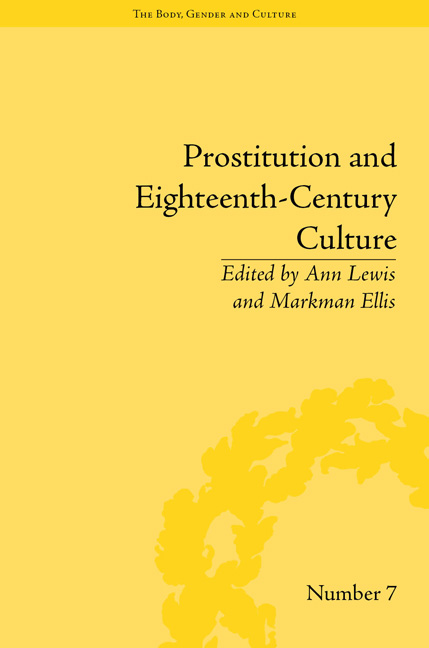Book contents
- Frontmatter
- CONTENTS
- Acknowledgements
- List of Contributors
- List of Figures and Tables
- Introduction: Venal Bodies – Prostitutes and Eighteenth-Century Culture
- Part I (Auto)Biographical and Classificatory Fictions: Madams, Courtesans, Whores
- Part II Visibility and Theatricality: Fiction, Image and Performance
- Part III The Magdalen House: Marriage, Motherhood, Social Reintegration
- Part IV Wider Perspectives: Constructing the Prostitute in Social History
- Notes
- Index
Introduction: Venal Bodies – Prostitutes and Eighteenth-Century Culture
- Frontmatter
- CONTENTS
- Acknowledgements
- List of Contributors
- List of Figures and Tables
- Introduction: Venal Bodies – Prostitutes and Eighteenth-Century Culture
- Part I (Auto)Biographical and Classificatory Fictions: Madams, Courtesans, Whores
- Part II Visibility and Theatricality: Fiction, Image and Performance
- Part III The Magdalen House: Marriage, Motherhood, Social Reintegration
- Part IV Wider Perspectives: Constructing the Prostitute in Social History
- Notes
- Index
Summary
Prostitutes, and prostitution, were notoriously visible in eighteenth-century European culture, a visibility that was amply reflected in political and cultural discourses. Commonly understood as an index of the moral temperature of society, the perceived increase in prostitution in the major cities of Europe offered its own conclusions. Moral reformers, who considered prostitutes a ‘common nuisance’, were numerous. In London, the Rev. William Dodd, writing in the Public Ledger in 1760, discovered in prostitution a telling sign of public vice:
Impudence no longer courts the shade. Let any man walk up a certain street leading from the Strand, and he will see numbers of unhappy prostitutes in the broad daylight, plying their miserable trade! Cannot this be prevented? – If not, where is decency? If it can, where are our magistrates? They are not ignorant of these things.
Pierre Jean Grosley, a French academician, in his A Tour to London (1772), reported that in 1765, prostitutes, or ‘Women of the Town’, as he called them,
were more numerous than at Paris, and have more liberty and effrontery than at Rome itself. About night-fall they range themselves in a file in the foot-paths of all the great streets, in companies of five or six, most of them dressed very genteelly. The low-taverns serve them as a retreat, to receive their gallants in: in those houses there is always a room set apart for this purpose. Whole rows of them accost passengers in the broad day-light; and above all, foreigners.
- Type
- Chapter
- Information
- Prostitution and Eighteenth-Century CultureSex, Commerce and Morality, pp. 1 - 16Publisher: Pickering & ChattoFirst published in: 2014



